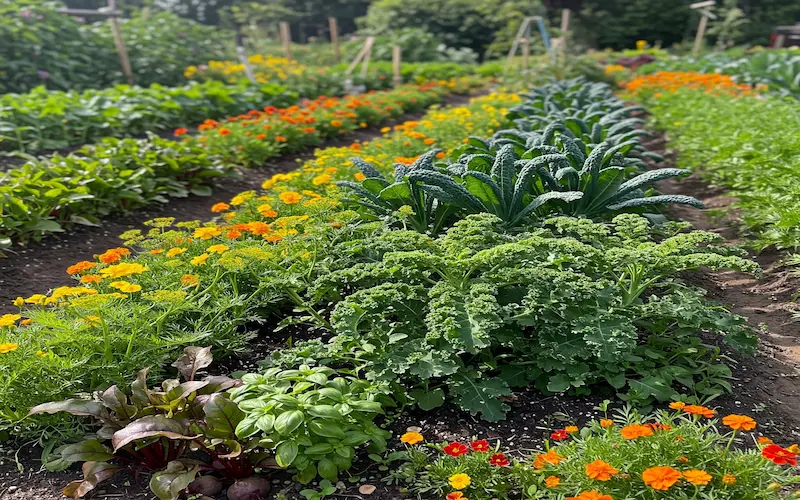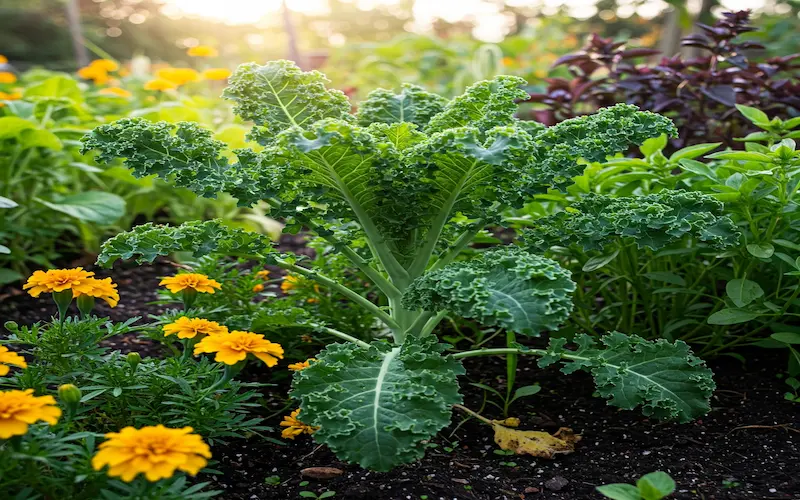Grow Better Kale! Best Companion Plants & What to Avoid
Published: 3 Feb 2025
Kale is a leafy green vegetable packed with nutrients. It is rich in vitamins A, C, and K, fiber, and antioxidants. This hardy plant grows well in cool weather and is a favorite among home gardeners due to its ability to thrive in various conditions.

Many gardeners use companion planting to grow kale best. This method involves increasing certain plants to improve growth, keep pests away, and enhance flavor. Some plants provide natural pest control and improve the soil or offer shade. Not all plants are good for companion planting. Some compete for nutrients or attract harmful insects.
This guide will explore the best and worst companion plants for kale. You will learn which plants help kale bloom and which ones to avoid for a healthy, productive garden.
What is Companion Planting?
Companion planting is growing different plants together to create a healthier and more productive garden. Some plants work well together because they help each other grow, repel pests, or improve soil quality. Others may compete for nutrients or attract harmful insects, making them bad companions.
Why Companion Planting Matters for Kale
Kale is a hardy vegetable. It can face challenges like pests, diseases, and nutrient competition. Here’s how companion planting benefits kale:
- Pest Control: Some plants naturally repel insects that attack kale, like cabbage worms and aphids. For example, marigolds and nasturtiums help keep pests away.
- Disease Prevention: Growing kale near the right plants can reduce the spread of soil-borne diseases. Avoiding plants from the cabbage family (like broccoli and cauliflower) helps prevent shared diseases.
- Improved Soil Health: To grow kale strong and healthy, Some companion plants, like legumes, add nutrients to the soil.
- Better Growth: Some plants provide shade or protection from harsh weather, creating a better-growing environment for kale.
Some companion plants are best for kale health and yield. They reduce the need for chemical pesticides or fertilizers.
Best Kale Companion Plants
Companion planting can help kale grow stronger, resist pests, and improve its health. Some plants protect kale from insects; some enhance soil quality and create a better growing environment. Here are the best companion plants for kale:

a. Herbs That Benefit Kale
Certain herbs can enhance kale’s growth, improve its flavour, and keep pests away.
- Basil – This aromatic herb helps repel pests like aphids and whiteflies that often attack kale. It also enhances soil health and may improve kale’s growth.
- Dill – Dill attracts beneficial insects such as ladybugs and parasitic wasps, which prey on harmful pests like aphids and cabbage worms.
- Chamomile – Chamomile is known for its medicinal properties, which improve soil health and enhance the flavour of kale. It also attracts pollinators and beneficial insects.
b. Vegetables That Grow Well with Kale
Some vegetables make excellent companions for kale because they don’t compete for nutrients and can improve soil conditions.
- Carrots – Carrots help loosen compacted soil, allowing kale roots to grow deeper and absorb more nutrients.
- Beets – These root vegetables don’t compete with kale for space or nutrients, making them great companions. They also help keep the soil moist.
- Celery – Celery naturally repels cabbage moths, a common pest for kale. It also grows well in the same cool-weather conditions as kale.
c. Flowers That Help Kale Thrive
Flowers can be very important in protecting kale by repelling pests and attracting beneficial insects.
- Marigolds – These bright flowers deter aphids, nematodes, and other pests that attack kale. Their strong scent also helps confuse harmful insects.
- Nasturtiums – Nasturtiums act as a “trap crop,” attracting pests like aphids and cabbage worms away from kale, which helps keep kale leaves healthy and pest-free.
You can create a healthier, more productive garden by planting kale with these companion plants.
Plants to Avoid Near Kale
Some plants can cause problems by competing for nutrients, attracting pests, or spreading diseases. To keep your kale healthy, avoid planting it near these incompatible companions.
a. Vegetables That Compete with Kale
Some vegetables take up the same nutrients that kale needs, leading to stunted growth and lower yields.
- Tomatoes – Tomatoes and kale both require a lot of nutrients, especially nitrogen. Growing them together can lead to competition, making both plants weaker. Tomatoes attract pests like whiteflies and aphids, which can harm kale.
- Strawberries – Strawberries are prone to fungal diseases, such as powdery mildew and grey mould, which can easily spread to kale. They also compete for space and nutrients in the soil.
b. Plants That Attract Harmful Pests
Some plants attract the same pests that feed on kale, increasing the risk of infestations.
- Cabbage Family (Broccoli, Cauliflower, Brussels Sprouts) – These vegetables belong to the same plant family as kale (Brassicaceae). They attract similar pests, such as cabbage worms, aphids, and flea beetles, making it harder to control infestations. Planting them together increases the risk of disease and pest outbreaks.
- Pole Beans – Pole beans can interfere with kale’s growth by competing for space and sunlight. They also attract aphids, which can spread to kale and damage its leaves.
Additional Tips for Successful Kale Companion Planting
Companion planting works best when combined with other good gardening practices. Here are a few tips to ensure your kale grows strong and healthy.
1. Rotate Crops Each Season
Planting kale in the same spot every year can deplete the soil of essential nutrients and increase the risk of diseases. To keep the soil healthy:
- Rotate kale with crops that restore nutrients, such as beans or peas.
- Avoid planting kale after other cabbage family members (broccoli, cauliflower, etc.) to prevent disease buildup.
2. Use Mulch to Retain Moisture and Suppress Weeds
Mulching helps moisten the soil, regulate temperature, and reduce weed growth. For best results:
- Use organic mulch like straw, wood chips, or shredded leaves.
- Apply a 2-3 inch layer around kale plants, but keep it slightly away from the stems to prevent rot.
3. Plant Kale Near Strong-Scented Herbs
some herbs with strong scents can naturally repel pests and protect kale from insect damage.
- Rosemary and thyme deter cabbage moths and flea beetles.
- Mint repels aphids and other common kale pests.
- Oregano and sage help create a protective barrier against harmful insects.
Following these tips and pairing kale with the right plants will create a growing, pest-resistant, and productive garden.
FAQs About Kale Companion Plants
Here are some common questions about companion planting with kale:
Yes, but with caution. Kale and spinach thrive in cool weather and have similar water and sunlight needs. They compete for nutrients, especially nitrogen. To reduce competition:
- Plant them at least 12 inches apart to allow proper root growth.
- Use compost or organic fertilizer to ensure both plants get enough nutrients.
Kale grows best in cool seasons, so the best planting times are:
- Spring: Plant kale with companion plants as soon as the soil is workable.
- Fall: Plant in late summer to enjoy a fall harvest with fewer pest problems.
- Avoid planting kale in hot summer.
Proper spacing is essential to prevent overcrowding, improve airflow, and reduce disease risks. Follow these guidelines:
- Small herbs (basil, dill, chamomile): 6–12 inches apart from kale.
- Vegetables (carrots, beets, celery): 12–18 inches apart.
- Flowers (marigolds, nasturtiums): 12–24 inches away to allow their roots to spread.
- Following proper spacing will create a balanced garden where plants support each other while minimizing competition and disease risks.
Conclusion
Companion planting is a simple yet effective way to grow healthier, stronger kale. By choosing the right plant partners, you can:
- Improve growth by pairing kale with nutrient-friendly plants like carrots and beets.
- Reduce pests with natural repellents like basil, rosemary, and marigolds.
- Enhance soil health by rotating crops and using mulch.
If you’re new to companion planting, experiment with different plant combinations to see what works best in your garden. Every garden is unique, and small adjustments can lead to big improvements!
Do you have experience growing kale with companion plants? Share your thoughts in the comments below! Have questions? Ask away—we’d love to help!

- Be Respectful
- Stay Relevant
- Stay Positive
- True Feedback
- Encourage Discussion
- Avoid Spamming
- No Fake News
- Don't Copy-Paste
- No Personal Attacks



- Be Respectful
- Stay Relevant
- Stay Positive
- True Feedback
- Encourage Discussion
- Avoid Spamming
- No Fake News
- Don't Copy-Paste
- No Personal Attacks




